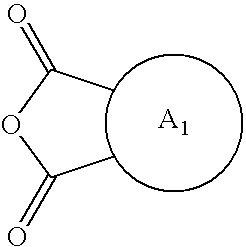Hybrid polymer materials for liquid crystal alignment layers
a liquid crystal alignment and hybrid technology, applied in the field of liquid crystal alignment materials, can solve the problems of reducing the electrical performance and optical stability of the device, affecting the long-term stability and performance of the device, and low assembly line throughpu
- Summary
- Abstract
- Description
- Claims
- Application Information
AI Technical Summary
Benefits of technology
Problems solved by technology
Method used
Image
Examples
example 1
[0115] The following example describes the synthesis of novel Addition Monomer 1 for use in the preparation of hybrid polymers of the invention.
3-[4-(6-Hydroxy-hexyloxy)-phenyl]-acrylic acid methyl ester
[0116]
[0117] Methyl 4-hydroxy cinnamate (40 g, 225 mmol) was dissolved in 300 ml of NMP. 6-Chlorohexanol (269 mmol, 36.8 g), anhydrous potassium carbonate (37.2 g, 269 mmol) and a catalytic amount of potassium iodide were added. The batch was stirred at 90° C. for 32 hours. Water was added to the cooled solution, which was subsequently extracted with 3×200 mls of ethyl acetate. The combined organics were washed with 10% KOH (2×100 mls), brine solution and then dried over magnesium sulfate. The concentrated product was then recrystallized from a 1:1 mixture of ethyl acetate / hexane to give 45 g (72% yield) of an off-white solid.
2-Methyl-acrylic acid 6-[4-(2-methoxycarbonyl-vinyl)-phenoxy]-hexyl ester, Addition Monomer 1
[0118]
[0119] To an ice-cooled solution of 20 g (72 mmol) 3-[4-(...
example 2
[0120] The following example describes the synthesis of novel Addition Monomer 3 for use in the preparation of hybrid polymers of the invention.
4-(6-Hydroxy-hexyloxy)-benzaldehyde
[0121]
[0122] 4-Hydroxybenzaldehyde (15 g, 122 mmol) was dissolved in 150 ml of NMP. 6-Chlorohexanol (20.16 g 146 mmol), anhydrous potassium carbonate (20.36 g, 146 mmol) and a catalytic amount of potassium iodide were added. The batch was stirred at 90 C for 24 hours. Water was added to the cooled solution, which was subsequently extracted with 3×100 mls of ethyl acetate. The combined organics were washed with 5% KOH (2×100 mls), brine solution and then dried over magnesium sulfate. The concentrated product was then recrystallized from a 1:1 mixture of ethyl acetate / hexane to give 14 g of an off-white solid.
3-[4-(6-Hydroxy-hexyloxy)-phenyl]-1-(4-iodo-phenyl)-propenone
[0123]
[0124] 4-Iodoacetophenone (2.46 g, 10 mmol) was dissolved in 20 ml toluene. 4-(6-Hydroxyhexyloxy)benzaldehyde (10 mmol, 2.22 g), pot...
example 3
[0129] The following example describes the synthesis of novel Pre-Functionalized Addition Monomer 1 used in the preparation of functionalized addition polymers.
(4-Vinyl-phenyl)-carbamic acid tert-butyl ester, Pre-Functionalized Addition Monomer 1
[0130]
[0131] To an ice cooled solution of 4-vinyl aniline (4 g, 33.6 mmol), triethylamine (3.72 g, 36.8 mmol) and 5 crystals of BHT in anhydrous tetrahydrofuran (40 ml) was added solid di-tertbutyldicarbonate (8.0 g, 36.7 mmol). The reaction was stirred at room temperature for 17.5 h, at which time 100 ml of 1M HCl was added and the solution extracted with 3×100 ml ethyl acetate. The combined organic layers were washed with 100 ml portions of water, 5% sodium hydrogen carbonate, water and brine and then dried with magnesium sulfate and concentrated. The material was recrystallized using 10% ethyl acetate in hexane, filtering while hot to remove insoluble byproducts, to give 3.0 g white solid, >99% pure by HPLC. H1 NMR (CDCl3): 7.34 (s, 5H)...
PUM
| Property | Measurement | Unit |
|---|---|---|
| mol % | aaaaa | aaaaa |
| mol % | aaaaa | aaaaa |
| wt % | aaaaa | aaaaa |
Abstract
Description
Claims
Application Information
 Login to View More
Login to View More - R&D
- Intellectual Property
- Life Sciences
- Materials
- Tech Scout
- Unparalleled Data Quality
- Higher Quality Content
- 60% Fewer Hallucinations
Browse by: Latest US Patents, China's latest patents, Technical Efficacy Thesaurus, Application Domain, Technology Topic, Popular Technical Reports.
© 2025 PatSnap. All rights reserved.Legal|Privacy policy|Modern Slavery Act Transparency Statement|Sitemap|About US| Contact US: help@patsnap.com



